The Forge Clerics, a cleric subclass that rose to popularity fast with the release of Xanathars Guide to Everything.
Its abilities and basic cleric skills make this a strong class that can rival any front-line fighter as well as any magic caster.
The options for this class are really something else, however, since they sport both strong magic casting as well as a strong defense be careful of not stretching yourself too thin.
So, if you are looking for a cleric subclass that sports both fun and strength, then definitely continue reading.
The Forge Cleric in 5e is an extremely strong subclass that function with high defense, strong firepower, and great utility. Making them one of the best clerics subraces to play in the game. Their Blessing of the Forge ability allows for great utility so you can either buff yourself or allies. Meanwhile, your 6th and 17th level put you god-like in terms of defense. And your Divine strike solidifies you as a powerhouse for a melee attack. Making this class sky blue in rating and coming fully online at the early level of level 6.
How Am I Evaluating The Forge Cleric Abilities?
So, before we begin the review, we should go over what I am rating and how I get my decision.
There are three things that I am looking over in the in-depth review.
I look over how strong the subclass is in combat, how much utility it has, and, if applicable, its’ roleplay ability.
This way everyone’s playstyle can be shown to fit their needs.
Now, when deciding if something is good for a guide, I look at what the subclass is trying to accomplish.
Then look at how successful it succeeds in that task.
For instance, in a previous article on the Bladesinger, I concluded it attempts to make you a competitive front line.
I then figure out how well that ability succeeds in letting you front line, as well as how soon it comes online.
If it is accomplished at level 2 then it is early game.
Level 6 it is Early-Mid, Level 10 Late-Mid, and Level 14 is late game.
I rate earlier tiers better as most Dungeon and Dragons Campaigns do not go beyond level 8.
Without further a due, let start this review on the Forge Cleric.
Color Coding: Meaning
GOLD- “That’s gold Jerry! Gold!” If an ability is highlighted gold, then this means that this ability not only is what defines your subclasses but accomplishes it better than almost any other subclass. I rarely do Gold ratings, so definitely pay attention to them if you see me do it.
Sky Blue –If the ability is sky blue, it means that this ability is a defining trait in your subclass but for one reason or another is not game-breaking like gold.
Blue- If it is just blue, then it’s a good ability but there are plenty of other abilities that perform better. Still better to have in a subclass than other colors.
Black. Black is ok. These are your more niche abilities that have bonuses in some situations but not useful in others.
Purple – Purple is for very niche abilities. They have times when they are good, but these are rare and almost never come up. Not the best color to see for an ability.
Red- Red is dead. It is the worse color to see on an ability. That said, no matter the color, an ability can work so don’t ignore a subclass if they have a red. Enough imagination and can-do attitude will make it okay but not optimal.
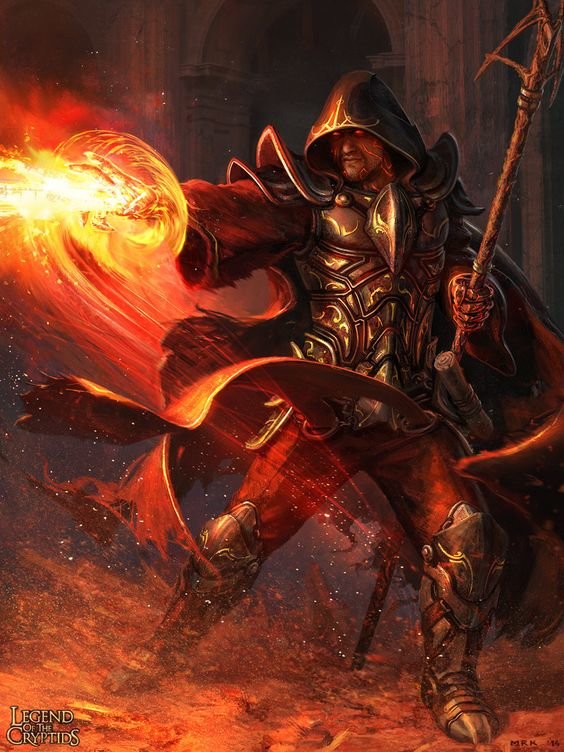
Forge Domain Spells
The list of additional spells you gain is decent.
The popular ones on the list are heat weapon and animate object.
So early on at level 3, you will get a spell great for doing damage and forcing disadvantage on an enemy.
Meanwhile, at 9th level, you will gain access to a spell notorious for throwing a fight into disarray with tiny objects attacking your foes.
Now, I would love to go into why these spells are so good, but today we are focusing on the abilities of the forge cleric.
So, if you want to know more about heat metal, then here is a Reddit post that does a great job at explaining why the spell is good. As well as a post that goes into the details behind animate object and their strengths here.
Forge Cleric: Bonus Proficiencies
When you choose this domain at 1st level, you gain proficiency with heavy armor and
smith’s tools.
The survivability of the forge cleric comes from their AC.
So, getting heavy armor is very good for the synergy of keeping this class alive.
After all, heavy armor proficiency is the only way to have an 18 AC without using a shield or magic.
Therefore, by getting this proficiency, you can increase your survivability by a large portion.
In fact, a standard shield, plate mail, and the cleric abilities, you can have a 22 AC. Which can be even higher with spells and magical items.
Meanwhile, smith tools are a solid choice for roleplay, as who better qualifies to be good with smith tools than a forge cleric.
They literally have forge in their name!
Moreover, smith tools are actually one of the more commonly used tool proficiencies uses.
Only behind alchemist supplies, herbalism kit, poisoner kit. So, gaining this proficiency has some pretty solid uses behind it.
Blessing Of The Forge
At 1st level, you gain the ability to imbue magic into a weapon or armor. At the end of a long rest, you can touch one nonmagical object that is a suit of armor or a simple or martial weapon. Until the end of your next long rest or until you die, the object becomes a magic item, granting a +1 bonus to AC if it’s armor or a +1 bonus to attack and damage rolls if it’s a weapon. Once you use this feature, you can’t use it again until you finish a long rest.
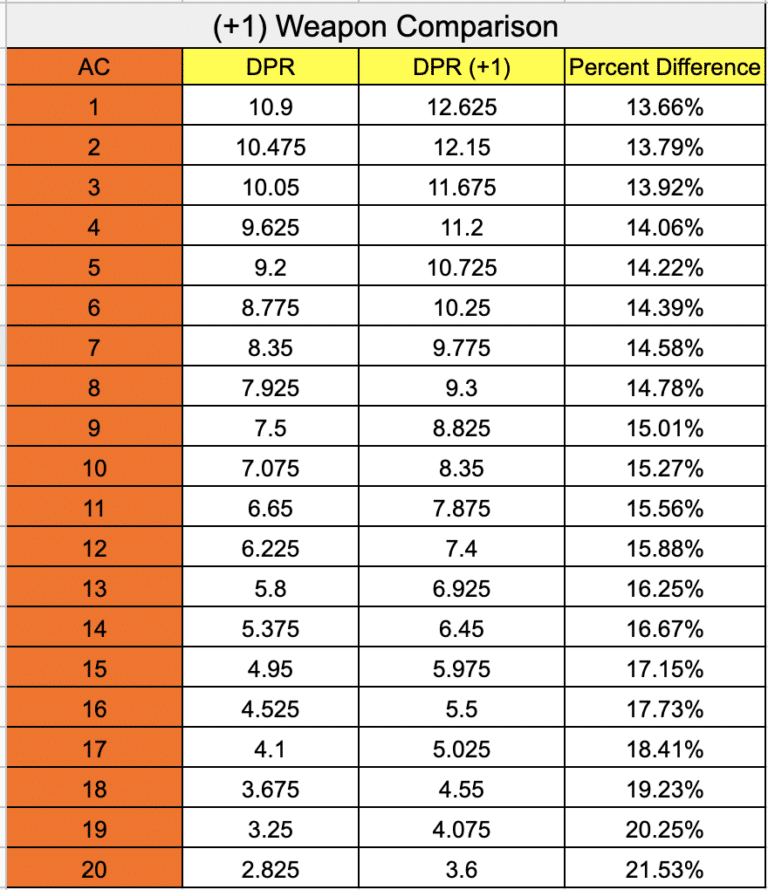
The first bread and butter of the class that makes you stand out in comparison to all others.
Plus 1 magical weapon or armor is sacred to adventurers it improves your chances of being missed from an enemy attack, or to increase your chances of hitting and dealing more damage.
As such, being at level 1 and getting your first +1 magic weapon greatly powers your character or others.
To prove how powerful it is, I calculated the damage difference to expect a +1 weapon will deal instead of a regular weapon.
The results were to be expected.
At a minimum, you will be doing 13% more damage to an enemy, with the damage getting higher the harder the monster is to hit.
Therefore at level 1, you have already increased a party member’s power by 13% before doing anything else.
This gets better when you notice this does not only apply to weapons.
This then adds a lot to your versatility to the party.
For example, say you find a +1 weapon.
Well, just switch to making your armor as +1 instead and have both +1 armor and weapons.
Then, say you have both magical armor and weapon.
Then just use your forge cleric’s “blessing of the forge” to buff an ally who is still waiting on that magical weapon.
Now, it should be noted that Jeremy Crawford announced on Twitter that it does not apply to shields.
A little unfortunate but still not going to ruin this.
This means this ability gets a sky-blue rating as it has great utility and combat for the forge cleric.
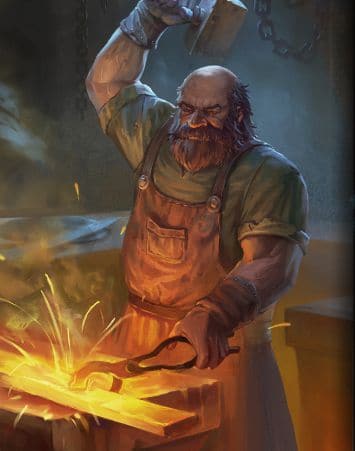
Channel Divinity: Artisan's Blessing
Starting at 2nd level, you can use your Channel Divinity to create simple items. You conduct an hour-long ritual that crafts a nonmagical item that must include some metal: a simple or martial weapon, a suit of armor, ten pieces of ammunition, a set of tools, or another metal object. The creation is completed at the end of the hour, coalescing in an unoccupied space of your choice on a surface within 5 feet of you. The thing you create can be something that is worth no more than 100 GP.
As part of this ritual, you must layout metal, which can include coins, with a value equal to the creation.
The metal irretrievably coalesces and transforms into the creation at the ritual’s end, magically forming even nonmetal parts of the creation.
The ritual can create a duplicate of a nonmagical item that contains metal, such as a key if you possess the original during the ritual.
Artisan’s Blessing: Why It Is Purple
Artisan’s blessing, a creative utility-filled channel divinity that has everyone thinking of ways to break it for the forge cleric.
Unfortunately, almost every single idea has been debunked or so heavily argued your DM is very unlikely to approve.
For example, there was the common application of the use of artisans blessing by making small chunks of the valuable plate armor and then putting them all together, so it is not one giant purchase.
This was proven to be “a stretch” according to Jeremy Crawford on Twitter.
So, unfortunately, that is out.
Then there is the idea to use it to create magical components such as a 50-gold piece diamond.
Just put 51 gold pieces down and use the forge cleric’s blessing to create a 50-gold diamond attached to a 1 gold piece ring.
This is still in debate and has not been confirmed nor denied by Wizard of the Coast.
Unfortunately, the wording of “metal object” implies for many DM’s that the majority of the item must be metal and not the other way around.
If your DM allows it though, this blessing gets even better for utility.
Artisans Blessing: What Can You Do?
Well, what can you do with Artisans Blessing?
The first and most obvious is anything stated, “simple or martial weapon, a suit of armor, ten pieces of ammunition, a set of tools, or another metal object.”
But, note that all things made by the forge cleric, must be less than 100 gold pieces according to Jeremy Crawford.
That said, you can also craft other metal objects which can be a multitude of things.
Create copies of all the keys from the guard so you can gain access to all sorts of different locations in the town.
Or destroy a metal cage and convert them to swords and armor so you can walk out and kill your imprisoners.
Then my favorite, repair armor that has been damaged fighting oozes and the like.
Other than these obvious ones, it is up to you and your DM on what can and cannot be done.
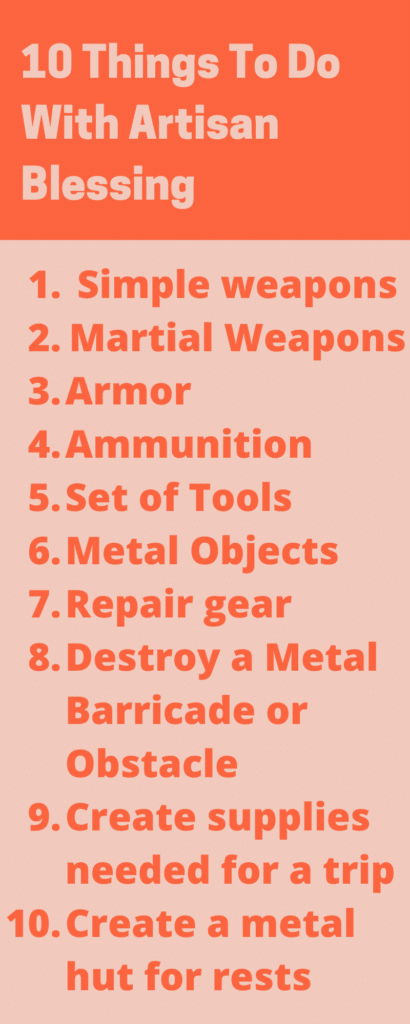
Soul Of The Forge
Starting at 6th level, your mastery of the forge grants you special abilities:
• You gain resistance to fire damage.
• While wearing heavy armor, you gain a +1 bonus to AC.
From Purple to Sky Blue. I love this for so many reasons.
One it is one of the only ways to boost ac from a sub-class.
Already putting this stronger than most others in terms of defensive subclass.
Then you get resistance to one of the most common elemental damages in the game. Again, fantastic!
In case you were wondering why a +1 is important, it is important for the sake of reducing damage.
Let’s say you are a party of 4 adventurers at level 6.
By this point, if you saved your money up wisely, you could have plate armor.
This gives you an AC of 18.
Then add a basic shield (+2), blessing of the forge (+1), and soul of the forge (+1). This without magical items will grant you a 22 AC.
Now, a deadly encounter at this level would be a young adult red dragon with +10 to hit.
Scary at first glance, but you become a great tank for being attacked at since you have a 55% chance of being missed from claw and bite attacks.
Meanwhile, your dexterity fighter will most likely have a 16 or 17 AC.
Meaning they only have a 25% chance of not being hit.
If this was not enough, gaining resistance to fire damage means even if you do
take the breath attack from the dragon, you would only take half damage if you
fail your save thanks to your resistance.
Then if you make it, you only take a fourth of the damage.
Making many magic users damage spells, demons, and dragons, not a huge threat.
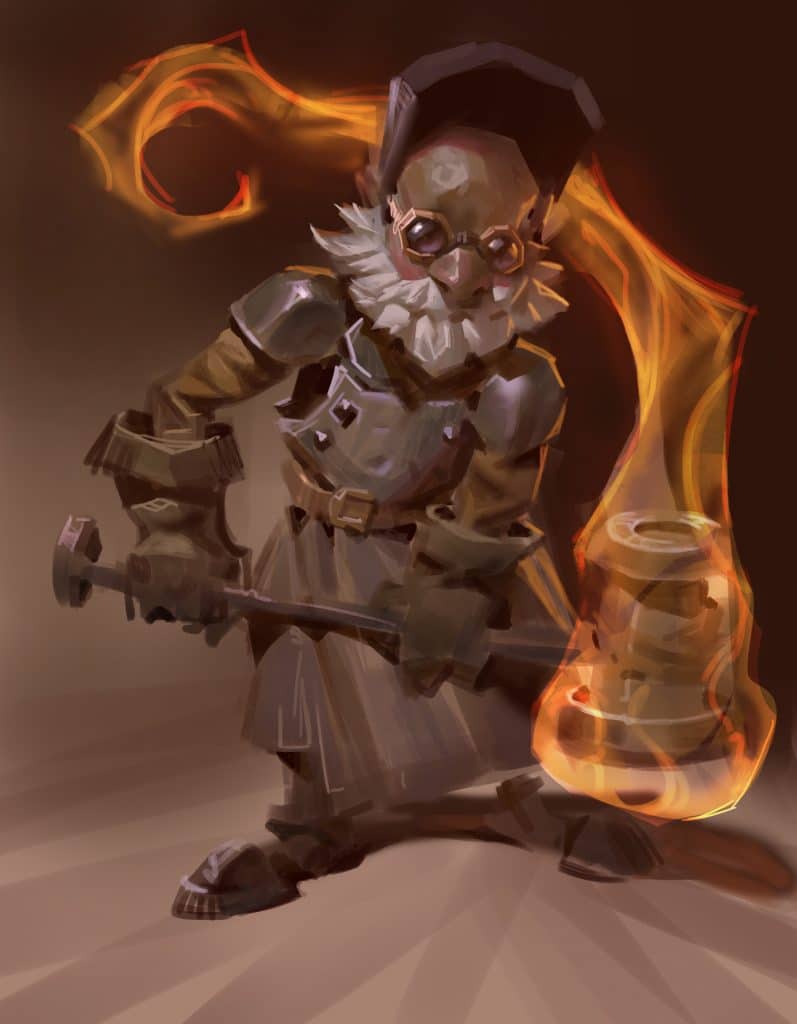
Forge Cleric: Divine Strike
At 8th level, you gain the ability to infuse your weapon strikes with the fiery power
of the forge. Once on each of your turns when you hit a creature with a weapon
attack, you can cause the attack to deal an extra 1d8 fire damage to the
target. When you reach 14th level, the extra damage increases to 2d8.
Honestly, I like divine strike.
It makes one attack much more powerful and actually beats damage cantrips at level 20.
The go-to cantrip at level 20 is sacred flame which would deal 4d8 (18) damage.
This would deal 3d8+5 (18.5) damage if you maxed strength out by level 20.
Then you can factor in other stuff such as a +1 magical sword or a flametongue longsword that would add an additional 2d6 (7) points of damage.
Making it better than cantrips.
Then why blue? Because at 8th level, you have 12 spell slots to use.
And in my experience, with proper resource control, you can easily make that last a whole day.
Even if you are brought down to your level 1 spells, guiding bolt deals 4d6 (14) damage which is the same as 2d8+5.
But guiding bolt also gives the next attack advantage, making it better.
This said, it still is a useful ability especially if you plan on being in the front lines as it guarantees you will always have a potent melee attack if you need it.
It is a shame it is one of the most resisted damages in the game.
But in all honesty, I would much rather have extra damage then no extra damage.
Saint Of Forge And Fire
At 17th
level, your blessed affinity with fire and metal becomes more powerful:
• You gain immunity to fire damage.
• While wearing heavy armor, you have resistance to bludgeoning, piercing, and
slashing damage from nonmagical attacks.
A gold rating.
Rare and fantastic.
This solidifies your place as one of the tankiest classes in the game. Like seriously, I love it so
much.
Okay, enough rambling. Immunity is strong. Like extremely strong.
The only other subclass that gives you immunity to an elemental damage is the Storm Sorcerer at 18th level.
And their immunity is the much less common lightning and thunder.
Meanwhile, only the yuan-ti race and level 10 monks grant you immunity to damage.
These are the only races or classes besides the forge cleric that have immunity to elemental damage.
Or to put it another way, even magic items are rare for giving you immunity.
The ring of fire elemental command is one item that grants the wearer fire immunity, and guess what?
It is a legendary magic item.
These are only seen once or twice per an entire campaign.
That is how rare these are.
So,when I say this deserves gold this definitely deserves gold.
Now let’s take a look at being resistance to all basic damage.
Not only do you get to be immune to a damage, you also gain the ability to tank
all basic attacks.
Making you, in my opinion, better than a standard barbarian
(excluding a few subclasses like the bear subclass).
As the barbarian’s tank ability is the ability to take half damage on all basic attacks.
Now you can do this, deal good melee damage, and cast spells.
Of course, that is at level 17, early on barbarian gets this ability and so are better at taking hits all around.
Dice For Forge Clerics
So I was torn, I love having a dice set for each character I plan on committing to.
It really helps create a personal feel between my character and me, like an unexplainable bond forms whenever I have a set of dice exclusively for them.
Maybe it’s just me, but because of this bond, I figured I would help people also forge their bond with their characters by giving my recommendation for a dice set.
That said, I was torn between choosing the Dragon Scale Dice Set, and the Worn Copper Dice Set.
As such, I figured I would include both and let you all decide.
Now I love the Dragon Scale Dice Set because of that bright red & orange symbolizes the flame that forges the weapons.
Meanwhile, the gold trim along with the metal dice really stands to show off the craftsmanship between the cleric and his works, representing a nobility in his craft.
That said, The Worn Copper is gorgeous for its simplicity.
To me, its’ polished copper look reminds me of a weapon that has been well taken care of over many years.
Which to my forge cleric, is what he wants all weapons to be, not something just well made but something that the owner appreciates and cherishes.
So both work perfectly well for any forge cleric and both roll extremely smoothly that I will let that decision rest on you (I ended up not deciding and buying both…. So good luck you forge clerics!
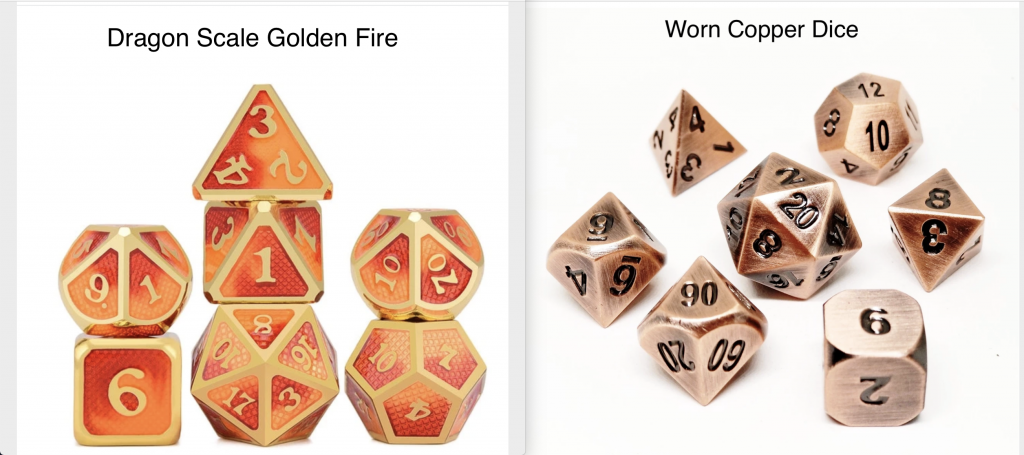
Forge Cleric: Conclusion
There is my review on the Forge Cleric in 5e.
They are a strong subclass that function with high defense, strong firepower, and great utility.
They truly start shining at level 6, but even before than gain incredible use with Blessing of the Forge ability to make the Forge Cleric sky blue overall.
If you love the forge cleric, then I suggest taking a look at Xanathars Guide to Everything.
It has quickly risen to be a very popular book with new unique subclasses that add ways to transform your characters into being entirely different from the previous subclasses in the Players Handbook.
Or, if you are that sold the forge cleric is your forever subclass.
Might I suggest looking into the triton subrace?
You gain an additional elemental resistance, more spells, and a bonus to strength and constitution.
Well, that’s everything so I hope you enjoyed my review on the forge cleric and tell me what you think in the comments. Hope your day is splendiferous!
- P.S. If you enjoyed this post and want to analyze your own spells, monsters, and party, download my D&D calculator! It’s a tool I use to calculate true DPR for spells and monsters in my campaigns. If you are still unsure by my little blurb then check out the review I made and see all the nifty abilities it has!

